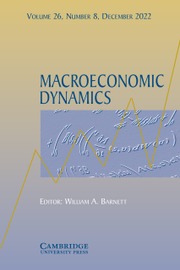No CrossRef data available.
Article contents
The great moderation and the financial cycle
Published online by Cambridge University Press: 15 September 2025
Abstract
I show that the defining features of the Great Moderation were a shift in output volatility toward medium-term fluctuations and a shift in the origin of those fluctuations from the real to the financial sector. I uncover a Granger-causal relationship whereby financial cycles attenuate short-term business cycle fluctuations while simultaneously amplifying longer-term fluctuations. As a result, financial shocks systematically drive medium-term output fluctuations, whereas real shocks drive short-term output fluctuations. I use these results to argue that the Great Moderation and Great Recession both resulted from the same economic forces. On the theoretical front, I show that long-run risk is a critical ingredient of DSGE models with financial sectors that seek to replicate these shifts. Finally, I use this DSGE model to refine the “good luck” and “good policy” hypotheses of the Great Moderation.
Information
- Type
- Articles
- Information
- Copyright
- © The Author(s), 2025. Published by Cambridge University Press
Footnotes
The views expressed in this paper are purely those of the author and may not in any circumstances be regarded as stating an official position of the European Commission. I thank the Editor William A. Barnett and two anonymous referees for the helpful comments and their reviews. I also thank Fabrice Collard, Patrick Feve, Christian Hellwig, Nour Meddahi, Ulrich Hege, Martial Dupaigne, Tiziana Assenza, Eugenia Gonzalez-Aguado, Andreas Schaab, Charles Brendon, Jordi Gali, Sebnem Kalemli-Ozcan, Ilse Lindelaub, Stephanie Schmitt-Grohe, Saki Bigio, Florin Bilbiie, Andreas Fuster, Luca Fornaro, Anmol Bhandari, Renato Faccini, the participants of the TSE macro workshop, EEA, EBES and UECE conferences, and the CIREQ doctoral colloquium for their helpful comments.
This paper was produced initially as part of my Ph.D. thesis at the Toulouse School of Economics. I am indebted to Fabrice Collard, Patrick Feve and Christian Hellwig for their mentorship, guidance and support throughout my Ph.D. Special thanks also go to Julien Matheron and Celine Poilly who served as referees in my Ph.D. Committee.

